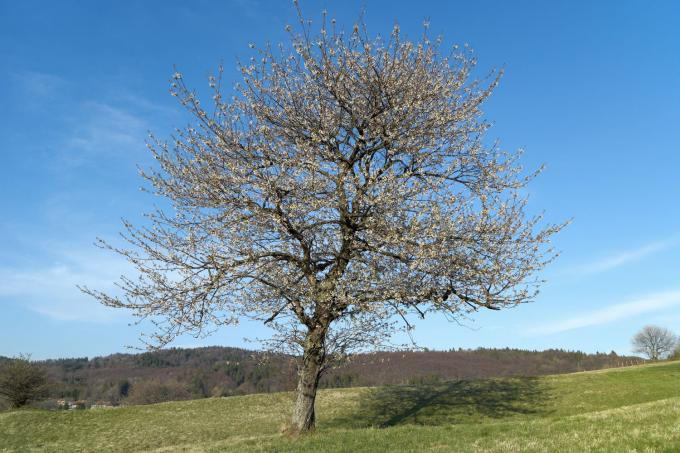The ‘Sonnenwirtsapfel’ is an all-rounder for the home garden. With its regular yield, its robustness against diseases and the picturesque growth it is an enrichment especially for orchards and rural gardens.

If you are looking for an apple to snack on, cook, bake and juice and would like to have little work with care and disease control, the ‘Sonnenwirtsapfel’ is very well advised. The large, picturesque tree also looks good and delivers a good amount of tasty and quite durable fruit every year in autumn.
"Contents"
- "Sonnenwirtsapfel": profile
- Origin and history
- Appearance and taste of the ‘sun host apple’
- Special features of cultivation and care
- Apple variety ‘Sonnenwirtsapfel’: harvest and use
"Sonnenwirtsapfel": profile
| fruit | medium to large in size; Greenish-yellow basic color with a matt to dark red covering color |
| taste | juicy, fruity with fine acidity |
| Yield | medium to high and regular |
| Harvest time | from September / October |
| Ripe for enjoyment | from November on |
| Shelf life | Well; storable until the end of February |
| growth | medium to strong; weakly branched |
| climate | low demand; can also be cultivated in higher altitudes |
| Diseases and pests | robust against diseases and pests |
Origin and history
In the town of Backnang in Baden Württemberg, the owner of a restaurant known as the "Sonnenwirt" found a seedling in the garden of his house. Because there is an apple of the kind nearby ‘Flamed cardinal‘Grew and the varieties are visually very similar, it can be assumed that the seedling was descended from this mother tree. However, the pollinating father variety is unknown. The variety was described for the first time in 1932 and has since found great approval in all of southern Germany in its use in orchards and private gardens. In 2017, the ‘Sonnenwirtsapfel’ was therefore chosen by the regional association for fruit growing, gardening and landscape as the fruit variety of the year.
Appearance and taste of the ‘sun host apple’
The fruit of the apple variety ‘Sonnenwirtsapfel’ is medium to large with a weight of 160 to 190 grams. The shape is variable from cylindrical and stem-bellied to flattened spherical. The halves are sometimes unevenly developed due to incomplete fertilization of the flower. In addition, three to five clearly visible edges are often formed on the rambur-shaped fruit. The shell has a greenish-yellow basic color, which is covered with a flat or flamed surface on the sunny side by a dull red to dark red covering color. The lenticels on the shell are often easily recognizable because they are surrounded by light rust. The shell on the tree is still covered by a clearly visible, waxy cuticle so that it appears white. The stem is usually very thick and shortened to a button. Under the skin there is a coarse-celled, firm and yellowish-white pulp. This is not only juicy, but also very appealing with a delicately sour, fruity taste.

Special features of cultivation and care
The apple variety ‘Sonnenwirtsapfel’ is a clear recommendation for the home garden. It thrives in high altitudes as well as in sheltered valleys and makes little demands on the soil and the climate. It also usually bears its fruit abundantly and regularly. The only drawback for smaller gardens is the medium to strong growth and the only weakly branching fruit wood. This does not necessarily mean that an annual pruning is necessary, but it is useful for harvesting large, high-quality apples. If the tree is spared radical cuts in the old wood, it can reach a great age, become very large and form an evenly spherical crown that hangs low on the sides.
Most recommendable is the culture as a high trunk or half trunk in an orchard, where the tree can develop and is only occasionally thinned out.
In the home garden, the ‘Sonnenwirtsapfel’ should be refined on a poorly growing base such as M27 or MM106 so that its growth is slowed down. Like all weak roots, a stable tree connection is required in this case, as the heavy crown cannot be held by the less stable root.
The apple tree ‘Sonnenwirtsapfel’ blooms mid-early in the year with a rather frost-resistant blossom. It absolutely needs a suitable pollinator in order to produce its large fruits. Other mid-early flowering varieties are suitable, such as ‘Cox orange‘,‘ Gray autumn stenette ’,‘ Idared ’,‘Josef Musch' or 'Cardinal Bea‘.
The fruit yield is usually regular and medium to high. If the fruit wood is not constantly renewed through regular pruning, the fruit size can decrease.
An owner of the "sun host apple" hardly has to fear diseases and pests, because the tree usually resists these reliably.

Apple variety ‘Sonnenwirtsapfel’: harvest and use
The harvest can begin between September and October, depending on the weather the ‘sun host apple’ experiences at its location. Apples harvested early are kept in the cool natural storage - i.e. dark in boxes in the (earth) cellar - until the end of February. The good taste makes the ‘Sonnenwirtsapfel’ a good table apple, but it is also ideal for must, cooking and, above all, baking.
The ‘Sonnenwirtsapfel’ is a versatile variety, only the size can be a problem. Unfortunately, suitable finishes with poor growth are not always available for the home garden. In addition, the rootstock is often not even identified and you buy a tree with a completely unknown growth potential. We'll tell you how to get around this by adding your Refine the apple tree yourself.
